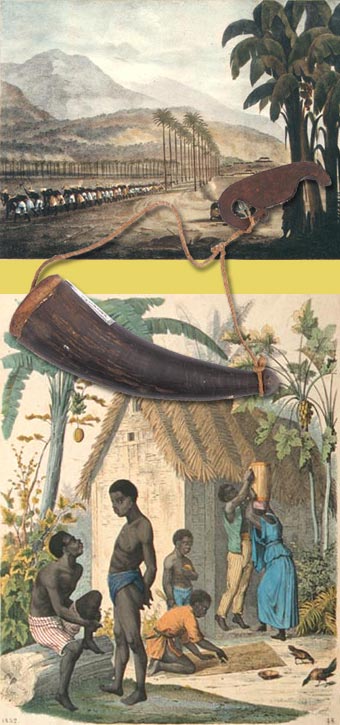
"Blacks shovel"
Right in the work, the slaves are here wearing a simple loincloth. The "black digger" specifically used for the heaviest work such as earthwork, is the category of most disadvantaged slaves. Members gnarled, bent backs and sore eyes reflect the daily suffering of these men, only force working to achieve and maintain major facilities that nature constantly calls into question. It is in the region of Approuague, where the administration had developed his most ambitious land reclamation project, that takes place in December 1790, a major revolt army of forty slaves. Slaves are much less Many in Guyana and in the French Caribbean islands or in the neighboring British and Dutch colonies.

Their living conditions of the homes are regulated by the police which provides workshops for teachers to provide only once a year a few pieces of cloth and a shirt and skirt for women, shirt, pants and a long hat for men. The slaves themselves produce a large share of their food by growing their giblets. The master's house, traditional Creole house framing with roof overhang and the front gallery, remains very rustic in Guyana. On farms in the lowlands, it is located near the canal for easy access. Looking for good ventilation, a major concern for protection from insects and limit the effects of an unhealthy climate, often justifies the construction of a floor. Large wooden buildings more summary form, the background, home probably industrial equipment (candy, mills, warehouses ...). On the right, correspond to the smaller boxes of slaves. The fences generally define the stockyards. The main agricultural products for export include cotton, annatto, coffee, cocoa and spices until the end of the XVIII th century. The tall green stalks, near which two slaves working the floor, reminiscent of sugar cane whose development in the lowlands ensures relative prosperity to the colony from the first half of the XIX th century. A large tree, in whose shadow is perhaps the commander responsible for the master to oversee all the work, has a trunk that builds on buttress roots, in French Guiana, very thin, is quickly depleted by intensive cultivation .

However the region is rich Amazonian palm species that provide some of the food supply of housing. Housing Savane Jappé Montsinery the neighborhood. The plan is the overall organization of a farm. The concession has not yet cleared spaces (large standing timber) or impractical (flooded savanna), areas planted and put into operation in annatto plant dye for export, and assigned to other slaves to grow their food (cassava slash). The dock connects Degrad or accommodation in the river leading to Cayenne. The house adjoining the master with an elegant garden, facing the "slave quarters" lined up before him. A tree "little leaf" using terminal is also featured: all time, the giants of the Guyanese forest serve as a benchmark. space colonized in the XVIII th century in a limited area between the rivers Kourou and Mahury appear different components of Guyanese society of the XVIII th century: Cayenne, capital of the colony address and port where the slave ships, along with the dense network of homes, the living space of the slaves. In addition to the types of crops grown, the card also mentions opening a communication channel by construction of a small river ("crack"), between the rivers and Montsinery Macouria. This world colonial with neighboring Amerindian villages ("Carbet Nouragues Indians"), sometimes identified by the name of a famous person ("hut of Apolimbo, famous Cuckoo"), or combined as part of a Jesuit mission (Mission of Father Lombard which houses the Galibis, Arouas and other Indians). Finally, the margins are reported of "runaway slaves or fugitives" in an area that is not yet inhabited. The development of the lowlands The idea of developing the lowlands along the lines of Suriname has been made since the early eighteenth th century, but is hampered by the lack of local government as settlers. The letter from Victor Hugues reflects the difficulty of mobilizing the relevant skills and the workforce needed. It says nothing of the arduous nature of the company: 200 men opened in four months, in a swamp area, a first channel section 3.5 km long, 12 meters wide and two deep, so that a second section of 2.7 km long and 6 meters wide. [http://www.histoire-image.org/pleincadre/index.php?i=743]

Channels, communication arteries in Guyana
In Guyana, slave labor is largely mobilized for creating agricultural production units, homes , vast areas of several hundred acres reclaimed by the forest clearing, as well as land use planning. From Cayenne, only open seaport on transatlantic routes, the settlement movement extends along estuaries and in swampy areas where ground transportation is impractical. Channels of the river system to complement the flow of productions. Slaves of the king, owned slaves and administration of private houses were requisitioned for the construction and maintenance of these waterways. Also in 1776, reclamation techniques inspired by those practiced in the neighboring colony of Dutch Guiana (Surinam) receive the impulse of the government, with the officer Pierre Victor Malouet and hydraulic engineer Samuel Guisan. The development of channels, useful for drainage and navigation, takes on new dimensions and allows to operate the lowlands of the country. [Author: Francoise Lemaire, http://www.histoire-image.org/pleincadre/index.php?i=743]

No comments:
Post a Comment